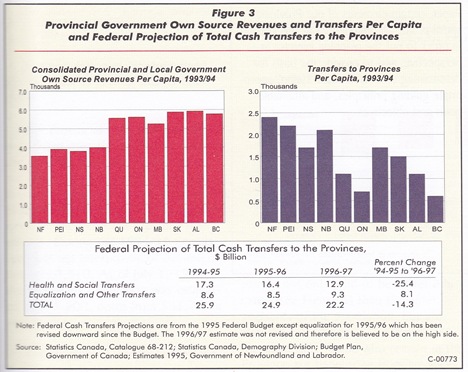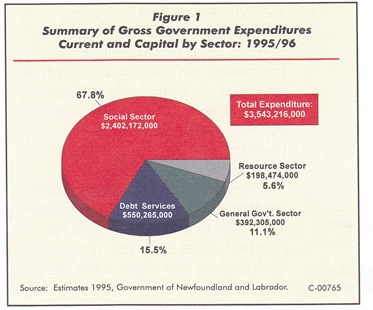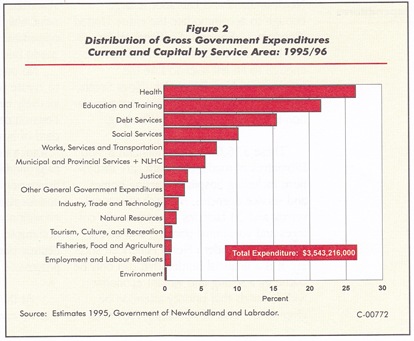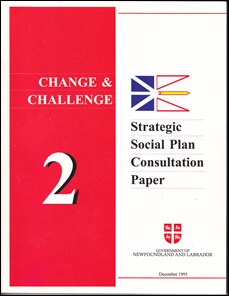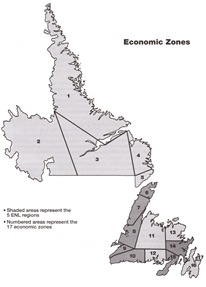Income Security Reform
During the past ten to fifteen years the Province's labour force has become strongly dependent on the income security system, particularly unemployment insurance. In many respects the current system is an inappropriate system of income security for a province such as Newfoundland and Labrador. While the Government is committed to ensuring basic income security for all households, our dependence on the present unemployment insurance system must change. As part of its strategic economic plan, the Government is therefore committed to working with the Federal Government to reform the income security system so that it encourages enterprise, education and employment, while continuing to provide basic income support.
It is important to recognize that the dependency on unemployment insurance is a national issue and not just a provincial concern. The Federal Government recently decided that unemployment insurance in Canada would be funded solely from contributions by employers and employees.
Employers and employees in this Province, however, contribute significantly less than the benefits received.
The unemployment insurance system was originally intended to provide temporary income to people seeking alternative employment who had lost their regular jobs in the work force. The system was not designed to provide basic income support, or as supplemental income for short-term, seasonal jobs. The present downturn in the economy has pointed to weaknesses in this system which must be addressed and corrected.
Strategy Statement. The Province will work with the Federal Government to ensure that the inevitable changes to the current income security system are designed so that basic income support is provided to every household, and that weaknesses in the present system are corrected to encourage the economic growth that is needed to reduce dependency on income security itself.
Actions. The Province will direct the Economic Recovery Commission (ERC) to undertake the following action and programs:
18. With support from other provincial agencies and in consultation with community groups, to work with officials from Employment and Immigration Canada to design an alternative income security system that both protects the income needs of Newfoundland and Labrador households and provides strong incentives for work, education and self-employment. The ERC will make recommendations to governments for implementing an alternative to regular
(non-fishermen's) unemployment insurance as a pilot project by 1993.
19. In consultation with other provincial and federal government agencies, the fishermen's union and the private sector, to design and recommend an Industry Stabilization and Insurance Program for Fishermen.
20. In consultation with appropriate federal, provincial and community-based agencies, devise a strategy to ensure that any short-term job creation projects that may be necessary during the interim, until a new system of income security is established, will provide meaningful work to participants and contribute to the long-term economic development of the Province.
21. Establish a Newfoundland and Labrador Conservation Corps which will channel funds into socially useful activities that will both contribute to environmental enhancement and provide valuable work experience and training for its members.
Labour Relations
There is a clear relationship between a positive labour-relations environment and a productive, viable economy. Our society has come to expect and demand certain employment standards to govern the relationship between employer and employee. It is now the challenge of labour, employers and Government to create a workplace and a workforce that is also productive, competitive and responsive to the current economic and social changes and pressures.
The importance of a positive labour-relations climate and the necessary partnership between Government, employers and labour were emphasized during the public consultation process on the development of this strategic economic plan. It was also observed that adversarial labour relations exist in Newfoundland and Labrador and that their existence impedes economic development. Participants in the consultation process suggested that the province can move forward to resolve its economic problems only if Government, employers and labour work cooperatively to address these problems and seek solutions.
Government supports the view that a stable, positive labour-relations climate is essential if we are to attract new investment in the province as well as to ensure a vigorous and competitive environment for existing businesses. A review of recent figures on work disruptions and person days lost because of work stoppages indicates encouraging signs of improvements; the statistics also show that there is no appreciable difference in work stoppages in the public and private sectors.
Because this Province has the highest proportion of unionized workers of all provinces in Canada, the operation of the collective bargaining process is particularly important here. Its flexibility allows it to represent workers' interests better than strict government regulation of the workplace. It also allows for the development of labour contracts appropriate to different workplaces. Too much direct regulation would result in reduced competitiveness and would destroy the appeal of collective bargaining in a system that should be responsive to a variety of needs.
Employers and workers together share the responsibility of creating a viable labour-relations environment; however, there is also an important role for Government. For example, our legislative framework requires government involvement before a strike or lockout can occur. The role of Government in this case is to provide services that can facilitate and encourage better communication between workers and employers. The recent preventive mediation program of Government underscores these important principles, but it is essential that the employers and workers themselves recognize their role and responsibility in the process. Mediation and conciliation may be effective in averting or reducing conflict but cannot help if parties consciously ignore or avoid these services.
A positive commitment by all parties involved is essential to successful labour relations and cannot be legislated or imposed by Government, though it can be encouraged and facilitated. Unions, workers, employers and Government must meet the challenge of continuing to improve labour-relations practices, especially when the economy, the composition of the workforce and the workplace itself are undergoing rapid and fundamental change. Recognition of the need for change provides a unique opportunity for improving the labour-relations climate.
To ensure that we can compete in an ever-expanding global marketplace employees and employers must work together. The challenge is to create a positive labour-relations environment which satisfies the aspirations of workers, minimizes work and family conflict and produces a well-trained and committed work force. Maintaining a balance between competitiveness and employment security must be a shared responsibility of labour, employers and Government. All three must recognize the conflicting pressures of global market forces and a growing demand for fundamental workers' rights and the collective bargaining process.
During the public consultation process, reference was made to the Province's other role as a major employer and the need to review the present policy of having different collective bargaining regimes for public and private sector employees.
Government can make an important contribution to the challenge unions, workers and employers face by increasing services that help the parties work together and by making all employers and employees aware of the importance of their own commitment to improved labour relations. While there is a clear link between a positive labour-relations environment and a productive business environment, it is equally clear that it takes a commitment from all parties to make it work.
Strategy Statement. The Province mil work to develop a stable, positive labour-relations climate to maintain and attract investment to the Province and to ensure a vigorous and competitive environment for economic development. Special emphasis will be placed on the development and use of innovative dispute resolution mechanisms and other workplace practices to minimize disruptions and enhance productivity for the mutual benefit of employers and workers.
Actions. The Province will:
22. Convene, within six months, a joint labour-management consultative committee, with both public- and private-sector representation. This committee will bring labour and management together at the provincial level to develop broad strategies for responding to restructuring and adjustment issues, to investigate and propose appropriate policy and program reforms (including new and innovative methods of dispute resolution), and to review the recommendations of the Background Report on Labour Relations to the Royal
Commission on Employment and Unemployment which are not yet implemented.
23. Appoint a Cabinet committee to address matters involving public-sector labour relations and Government's role as the major employer in the Province.
24. Establish, during the next year, tri-partite committees of employers, employees and Government for each major sector of the economy to develop a better understanding of, and to discuss and advise on, labour matters. These committees will meet regularly with the appropriate Cabinet Ministers to ensure improved communication among the interest groups.
25. In consultation with management and labour, establish a Labour-Relations Education and Research Centre which will develop new skills and strategies for effective collaboration, communication, mediation, arbitration, health and safety planning, grievance procedures, conciliation and collective bargaining. This Centre will be associated with a post-secondary institution which will adopt as its area of specialization the new mandate for labour-relations education.
26. Ensure there is a partnership between business and labour to provide information on the role, importance and mechanisms for positive labour relations at the secondary and post-secondary educational institutions.
27. Allocate additional financial and human resources to the promotion and delivery of the Preventive Mediation Program.
28. Undertake a thorough review of legislation relating to labour relations; consolidating all collective bargaining legislation will be considered.
29. Establish immediately a labour-management cooperation fund to provide cost-shared financial support to projects jointly sponsored by labour and management, such as those related to improved communication, productivity or labour relations.
-srbp-
Change and Challenge: Chapter 4(4)
